27/10/12 Filed in: Fall

Chickadee Feeding: ISO 640, 140mm, f/5.6, 1/750
This is another shot from my previous post. Waiting for the Blue Jays to come to the feeder and tis small guy kept fluttering from the trees to the feeder.
That is a sunflower seed in his bill.
13/10/12 Filed in: Fall

Yellow Rumped Warbler: ISO 640, 360mm, f/5.6, 1/1000
It has been awhile since I last updated my journal. When I started this project I wanted to post at least once a week. It seems now I am lucky to post at least once a month. Life is racing by and I have little time for my passion of photography. I have to make a conscious effort to not let this happen. I have to remember why I love spending time with my cameras.
The above image is such an example of why I must make this time.
Last month (September) Blue Jays were coming to my backyard feeders carrying away food for fall. Blue Jays love to hide food almost anywhere including compost heaps, eavestroughs, planters etc. I grabbed my cameras and sat on the deck by the feeder waiting for these big birds to return for more food.
As I waited patiently I started snapping shots of the other birds playing in the backyard. First, it was the common house sparrows. Then a chickadee fluttered back and forth from the trees to the feeder. Then I noticed a moving patch of yellow in the apple tree. I quickly focused and got a shot of this bird.
When new birds come to the backyard I usually want to get reference pictures so that I can identify them later with my Peterson Field Guide. I don’t want to scare the bird so as you can see my zoom is out quite away (360mm). I am hand holding the camera as birds tend to move about rapidly. To get the fast shutter speed I have to turn the ISO up. The picture isn’t the sharpest under these conditions but I usually have enough good snap shots to be able to identify the new visitor.
From my research in the Peterson Field Guide and Google I came to the conclusion this was a Yellow Rumped Warbler. I posted this image on Flickr and had one of my contacts confirm that I identified this bird correctly.
I am excited by these new finds. I live within a 10 minute walk to downtown of a city with close to 92,000 people. The backyard is like an oasis in this busy city. I must take the time to stop and marvel at the sights and not let life get too busy for my passions.
16/08/12 Filed in: Summer
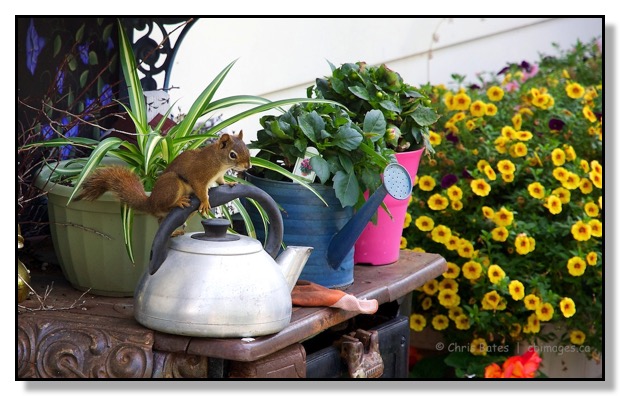
Hide and Seek Squirrel: ISO 250, 85mm, f/5.6, 1/180

Hide and Seek Squirrel II: ISO 250, 85mm, f/5.6, 1/180
I was cooking Sunday supper at the BBQ when I noticed something running back and forth along our garage wall. I turned around and this squirrel wanted to play Hide n’Seek or Peek-a-boo.
At the time I only had my iPhone in my pocket. I called into the house for Angela to grab the “Heavy Duty” camera. I thought I was too late as the squirrel had vanished.
A few minutes later he had come back to play his games with me.

Squirrel on old Wheel: ISO 250, 80mm, f/5.6, 1/60
The shot above you can see that the tail is out of focus. He was busy twitching it. Warning me that he was getting agitated with how close I was getting.
The squirrels in the neighbourhood are busy foraging for food. They have been chewing off branches of the neighbour’s Mountain Ash tree to get the berries. Today, I watched another one busy carrying pines cones along the neighbour’s fence.
28/07/12 Filed in: Summer

Orange Lily: ISO 200, 35mm, f/5.6, 1/800
Our neighbour over the last couple of years has given us lilies to plant in our garden. I guess they multiply rapidly and she doesn’t like to waste flowers. I believe she sees them as a major investment.
This year they have finally bloomed and there is an abundance of them. I cheated by adding a little Miracle Grow a few times.
This was taken a couple of evenings ago as the sun was setting. I was trying to capture the shadows of the stamen and carpel of the plant. See Mom, I paid attention in science class!
19/07/12 Filed in: Summer
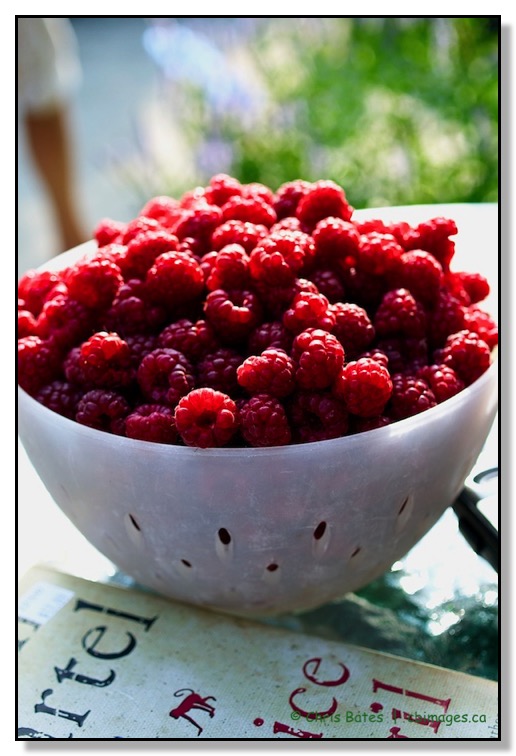
Bowl of Raspberries: ISO 200, 35mm, f/3.5, 1/500
So far this summer we have had a couple of weeks of very warm weather. The raspberries in our backyard garden have ripened overnight. I picked these tonight and I could have filled another two containers this size.
After posting this entry I will be grabbing the ice cream. Bon Appetit!!
15/07/12 Filed in: Summer
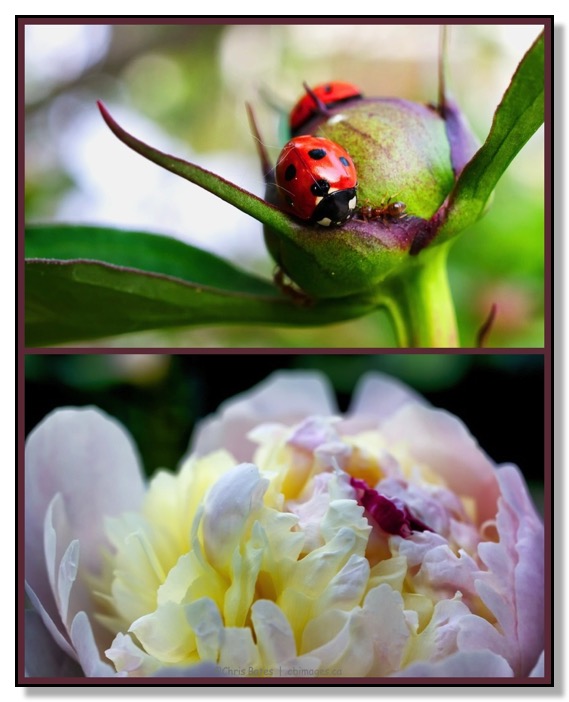
Before and After: Peony Bud and Bloom
We have a few peony plants in our garden. We notice that ants seem to love the bud heads in early spring.
After doing some reading the peony and ant seem to have a symbiotic relationship. The peony bud produces nectar to attract ants. The ants are protective of food sources which in turn will keep other pests away. The end result is well feed ants and beautiful and huge peony blooms.
04/07/12 Filed in: Summer
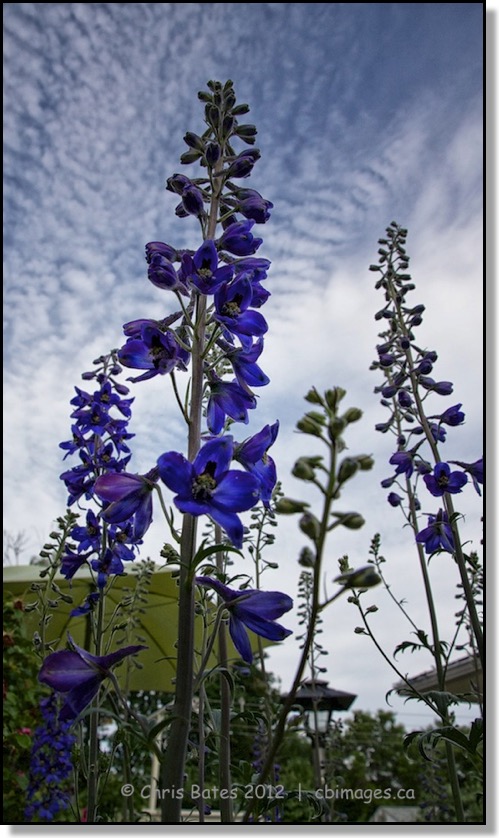
Delphinium Sky: ISO 200, 15mm, F/8, 1/500
We are experiencing a lot of rain this spring/summer. Our gardens are growing fast with the July heat. These Delphiniums are almost as tall as me (6 Feet).
I thought I would try a different perspective using my wide angle lens. On my knees looking up to the big Alberta sky.
23/06/12 Filed in: Summer
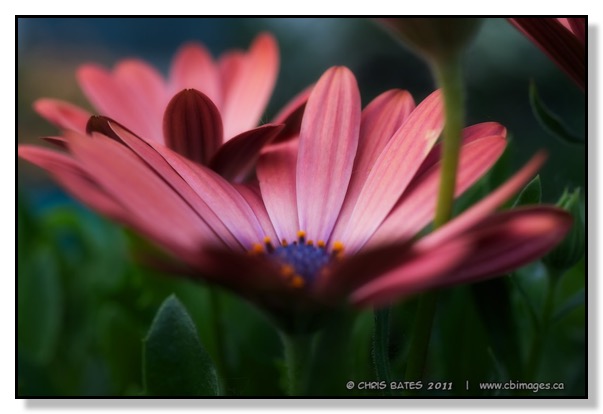
African Daisy: ISO200, 35mm, f/4.0, 1/160
I took this shot of African Daisies (Osteospermums) a couple of evenings ago.
My mother in law was visiting from Vancouver and had asked me why my flower shots were getting better colours than hers. (She uses a little Canon Point and Shoot camera.) I informed her that the worst time to take pictures of flowers is when the sun is very bright and high in the sky. The best time for flower photography is when the sun is low or when it is overcast with clouds.
One can use polarizing filters during sunny days to help achieve better colours as well. With her point and shoot camera this might prove difficult.
So, as I was walking the garden with my camera she was following me with hers. At the time it was early evening and had a light cloud overhead. As she snapped her pictures she noticed the difference and seen what I was talking about.
22/06/12 Filed in: Spring

Ladybug and Ant: ISO 800, 35mm, f/7.1, 1/100
As promised another ladybug image to share.
This ladybug is sharing a peony bud with an ant. The ladybug was sitting perfectly still while the ant was probing this large creature with her antenna.
10/06/12 Filed in: Spring
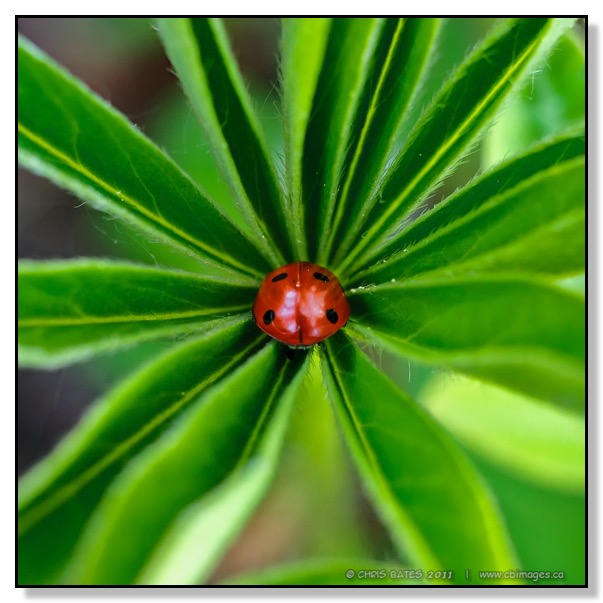
Ladybug on Lupin (Bottoms Up): ISO 800, 35mm, f/5.0, 1/30
Angela pointed this opportunity out to me on on of her afternoon backyard garden walks.
Just like the previous image, I have used my Tokina 35mm 2.8 Macro lens to capture this close up of a Ladybug head first in a branch of Lupin leaves.
This year we seem to have an over abundance of ladybugs in our backyard. I will have more images to share.
30/05/12 Filed in: Spring
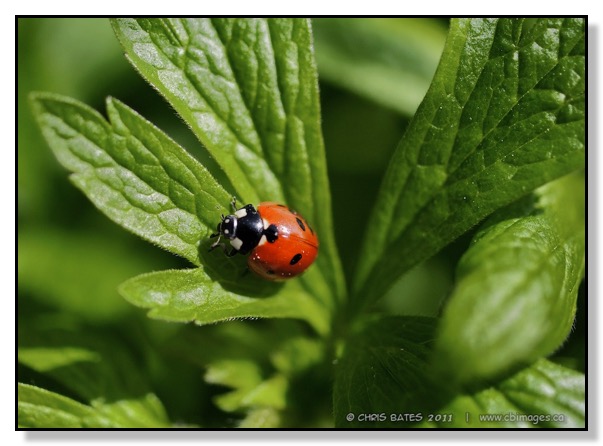
Ladybug on Leaf: ISO 800, 35mm, f/2.8, 1/4000
I was enjoying the spring sunshine one afternoon last week and noticed this lone ladybug checking out the leafy foliage of some of our perennials.
I used my Tokina 35mm f/2.8 macro lens to capture this image.
22/05/12 Filed in: Spring
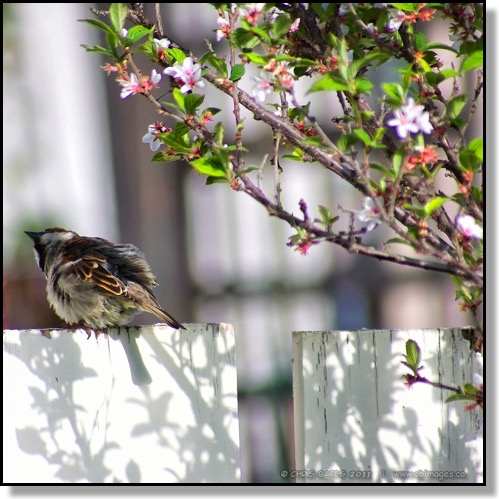
House Sparrow fluffing up his feathers: ISO 200, 320mm, f/5.6, 1/1500
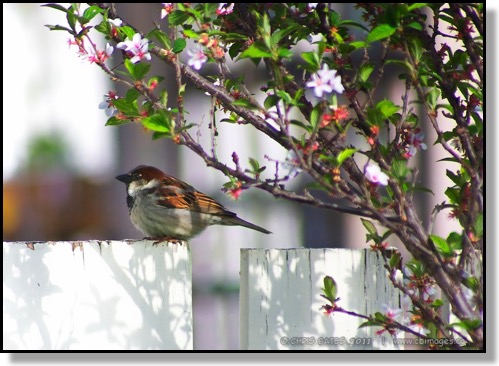
Sitting on the Fence: ISO 200, 320mm, f/5.6, 1/1500
Spring feels like it is finally here. The birds are out playing and enjoying the new foliage.
The above shots are of the same male house sparrow. Enjoying the sun while sitting on our fence.
26/04/12 Filed in: Spring

Half Eaten Tulips: ISO 200, 47mm, f/2.8, 1/500
This past winter the deers took a liking to our backyard. At first I thought this was pretty neat then I seen all the deer droppings.
I also noticed that the birds were no longer visiting our feeder. Even the magpies and crows were staying away.
I managed to get a shot of a deer at our bird feeder helping himself to the nice mixture of seeds and nuts early one morning. The quality is not the greatest. I was fresh out of bed and quickly set the camera settings to ISO 800 and shot with the lens wide open. I also had to shoot through our dirty back door window so that I would not startle the deer before he ran away.
This is why the birds have not been visiting. I will have to give the feeder a real good cleaning hoping to wash the deer smell off it!
As the snow started to melt and the spring flowers came up I noticed that they were also a tempting food source for our four legged friends as you can see by the picture above. I will not have many tulip pictures this spring as the deer have eaten most of them.

Deer at Bird Feeder: ISO 800, 35mm, f/2.8, 1/13
Tip: When taking photos of wildlife I have learned that it is best to take your shots early and then move in a step and take another shot. Keep doing this in a slow steady action until the subject “flees”.
13/03/12 Filed in: Winter
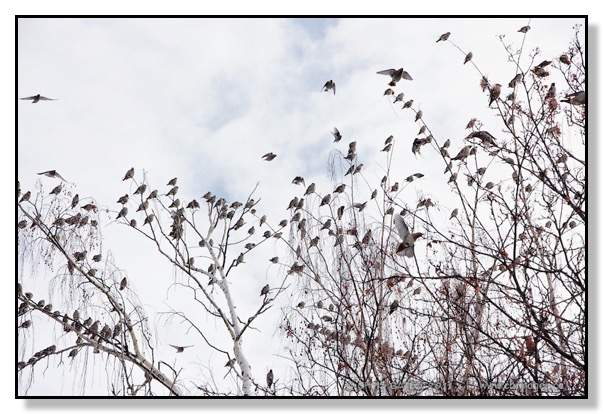
Birds: ISO 200, 53mm, f/4.5, 1/4000
A followup to my previous post.
This is where the flock of flying waxwings were headed. The neighbour’s Mountain Ash (Right Side of Picture) provides many tiny berries for a large quantity of birds to feed. I wonder how these tiny branches can handle the number of birds that perch on them.
05/03/12 Filed in: Winter
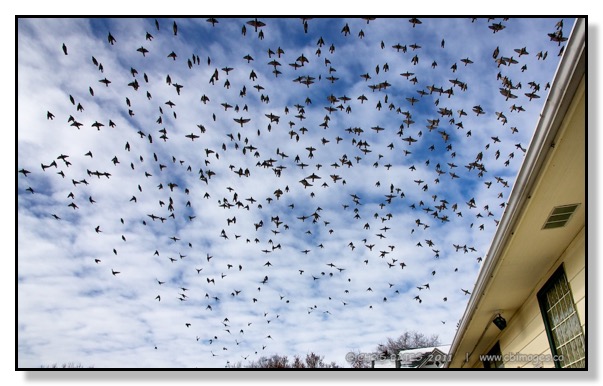
Formation Flying: ISO 200, 15mm, f/8.0, 1/2000
The bohemian waxwings came back to our yard this winter for another feeding. The sound this amount of birds make is surreal.
This is just a small bunch of the birds. Most of them were in the trees behind me feasting.
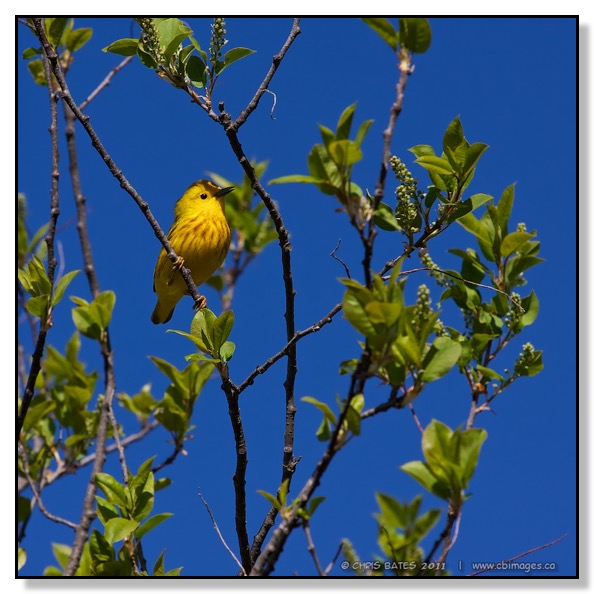
Yellow Warbler: ISO 200, 200mm, f/8.0, 1/750
Waiting for spring to arrive. This yellow warbler was captured last spring at the Kerry Wood Nature Centre, Red Deer, Alberta during one of my nature walks.